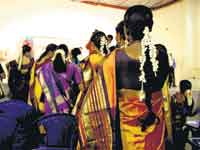| Demand for silk products rises but raw material a problem
KANDY – Silk which has always been a majestic symbol in the oriental kingdoms in the past and it still stands for wealth, class and style in the modern world. Silk sarees are also popular among the ladies, even the modern sophisticated city women. In fact R. S. Balanathan, Chairman of KoLanka Pure Silk (Pvt) Ltd and President of the Handloom Association of Central and Wayaba Provinces told me that many of his customers are ladies from the city.
The KoLanka silk workshop is the only industrial silk manufacturer in the country and it was started in 1989. Balanathan and his wife took the initiative and started the workshop with only three machines. The business grew steadily and they boasted of a sizable market share in Japan for traditional kimono belts which were made out of pure silk. However, with the entry of China into the Japanese market in 1998, KoLanka Pure Silk started losing its market share and it had to cut down their workforce of 206 weavers to about 16 workers. Since then KoLanka Pure Silk has made a come back and is growing steadily and Balanathan hopes to open another workshop with about a minimum of 20 machines soon. “My products are very high quality so when the tourists come to my workshop [to buy products] they come again when they visit Sri Lanka,” he said proudly. He said he often receives orders from foreign countries when he takes part in promotional exhibitions held by the Sri Lanka Textiles Ministry and through his own contacts. In expanding the business KoLanka Pure Silk has opened an outlet in Colombo to be closer to their main local customers: high class women in the city. However it hasn't always been an easy journey. After the government-run silk production plant (Beri culture) closed, Balanathan has had to import silk from Korea and it costs him about Rs 8,500 a kg whereas it was just Rs 2,500 locally. According to him the silk plant which was under the Ministry of Plantation closed down in 2000 because of high costs which he says was true but points out that there is huge potential for the industry if it was restarted. “I would like to start my own production line but it’s costly. If the government starts production or any foreign company comes in I can work with them,” he says. Balanathan’s biggest problem is not the silk but finding weavers for his workshops. “I have a good demand for my products; I have the technology; I have the machinery, but I don’t have enough weavers to meet demand,” he said. According to him, most young girls do not like weaving as it is a traditional craft and go more for modern jobs in the garment industry. The problem is the public image of weavers, Balanathan said, adding, however, that the government is also aware of this situation and is trying to remedy it by giving the trainee weavers an allowance of Rs 2,500. At KoLanka, Balanathan gives an additional Rs
2,000 for the trainees as an incentive to remain in the company.
The planned second workshop will be located in a rural area where
he can find weavers as a remedy to the problem. He is hoping that
a proposed pension scheme for the weavers – which is planned
– will encourage the younger crowd to take up jobs in textile
weaving. |
||||
Copyright © 2006 Wijeya Newspapers
Ltd. All rights reserved. |
